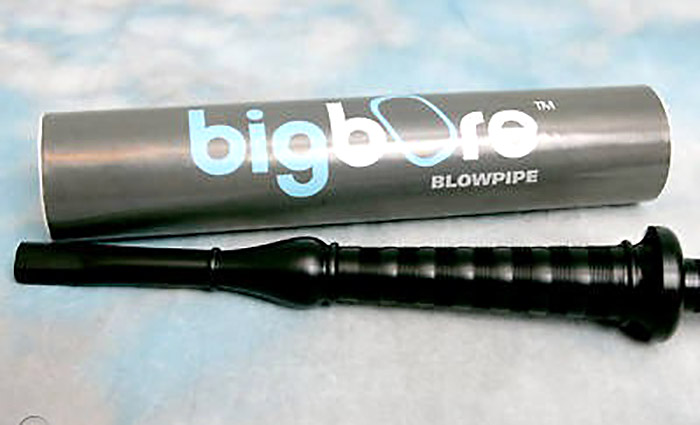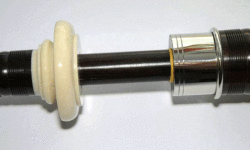
One of our readers in Sweden has pointed out an article which appeared somewhere on the internet in which the writer complained of an increasing prevalance of bad blowing among amateur and lower grade band players.
He blamed the problem on the growing popularity of wide bore blowsticks. I’m afraid this analysis defies logic.
By The Editor
The purpose of the wide bore blowstick is to facilitate the flow of air into the bag. It is for this reason that, back in the old days, we were always encouraged to get the thin brush into the bore to dislodge what was happily growing there, and which restricted us doing the very thing the blowstick was made for – getting air into the bag.
It was a pretty disgusting process at times, but there was no doubting the fact that when the gunge was gone the blowing was easier. We did it before every World Pipe Band Championship but should have been more attentive to this ablutionary process.
The roughish internal bore of the blackwood seemed to encourage every bit of mould, fungi or algae (help me out here you biologists) to linger in the dark, moist, chamber.
[wds id=”2″]
I now take the example of the poor man struggling with a clogged artery to the heart. The aneasthetic is local. In goes the small camera to identify the blockage that is causing breathlessness and pain.
Next, up the arm travels a stent, the conscious patient watching on the big screen. The surgeon uses this stent to expand the artery wall. The blood flows and instantly the patient feels a new man.
A similar health improvement will be felt in your bagpipe when you facilitate a smooth passage of air into the bag. Any problem with bad blowing comes south of the one-way valve.
Firstly satisfy yourself that the valve itself is not leaking – and don’t use one that fits inside the bore as these restrict air flow. Now check that bag. Is it airtight, I mean really airtight?
Any problem with blowing comes south of the one-way valve….
Strip down the pipe, get corking and test. Place the inflated bag on the floor. Apply pressure with your knee. Quick deflation and you have a problem. Still not sure? Put it in the bath, blow it up and watch for bubbles.
If it is a skin bag and the seam leaks, you can try more seasoning, but usually it needs replaced. Alternatively you might find you are losing air at the stocks themselves. If so, re-tie.
Synthetic bags are expensive. Recent purchases that leak should be taken back to the manufacturer.
Next make sure your reeds are taking the minimum of air. Never play a pipe that is too strong for you. This goes for band pipers as well as solo. Have a look at the top pipers in Grade 1. Do they look as if they are struggling to blow?
Want more handy tips on how to maintain your bagpipe? It’s all here with video assistance:
[wds id=”9″]If that chanter reed won’t ‘speak’ easily, check the opening and the amount of cane on the blades. Pare down if necessary, a little at a time.
Have a look in the mirror as you play. Is that bass drone top moving about like a ship’s mast on a heaving sea? If so there is still something wrong. Something far wrong.
Check all your hemping. Using dry hemp at the stocks is fatal. A few days of non-playing and these joints will be loose and leaking. Don’t be lazy. A quick lick of saliva is not the solution. Strip off the old hemp and replace it with well waxed stuff. It’s proofed against variations in humidity.
Finally when you are convinced you have done all of the above look to yourself. Check that mirror again. Think about your bag arm. Is it rock solid at all times? Do you maintain its pressure on the bag no matter the tune you play? It is remarkable how many pipers forget about arm pressure when they encounter difficult tunes.
Lower grade bands hit the strathspey and the blowing goes to you know where. Back into the safety of the 3/4 and voila! Now where did that good tone come from? I’ll tell you; it was from the arm pressure suddenly reasserting itself once the fingering worries were over.
In summary I’m afraid to say that our ‘big bore = bad blowing’ theorist is talking tosh. One of the great advancements in pipe playing of the recent past has been the development and improvement in the blowstick. Synthetic is best, and the bigger the bore the better.
-
 The Fyrish Collection, a digital pipe music book by Niall Matheson£12.00
The Fyrish Collection, a digital pipe music book by Niall Matheson£12.00 -
 10 Tutor Books for Schools/ Bands/ Trade£105.00
10 Tutor Books for Schools/ Bands/ Trade£105.00 -
 Bagpipes – DN1, High Quality InstrumentPrice range: £100.00 through £1,250.00
Bagpipes – DN1, High Quality InstrumentPrice range: £100.00 through £1,250.00
















Sorry, it is not “Tell me to order one” , it should be “Tell them to order one”.
In recent years I have got two newly-built sets with ABW blow pipes and with all the beautiful decorations & real ivory on them, yet, they were both put aside after I tried a big bore for the first time.
It will be great if manufacturers and refurbishers can make a bog bore with ABW.
Caution : NEVER lend your big bore blowpipe to your teammates for trial in today’s Covid-19 situation. Tell me to order one !
“Little Mac” valves are the worst invention ever for blowsticks.
The amount of split wood I’ve seen due to forcing them in beggars belief.
The blow pipe article is interesting. I have never had particular problem with blowpipes, but have always looked for anything to ease the process of blowing air into the bag. Of course the blow piece and stock is subjected to fairly extremes in moisture and it is not unknown for cracking to take place or rot of the wood at the joint between the wooden blow stick and synthetic or ivory blow piece. Cracking or damage to that joint obviously can cause leakage of air. Over the years, I suppose I have gone through a few blow sticks. Occasionally with the use of a lathe, I have enlarged the bore and this resulted in easing the effort of blowing. It does not in anyway diminish the sound or make the blowing unsteady. Unsteady blowing technique would be down to the lack of practice or if playing a long piece, having the reeds set too strong. A leaking pipe bag or a leaking blow stick or valve is undoubtedly the recipe for unsteady blowing. Learners frequently do need help in blowing technique and in fact some experienced pipers find it difficult.
In recent times I have gone for synthetic blow pieces with bigger bores and find they are of benefit. One particular aspect of improvement, which I was sceptical about was the shape of the mouth end of the newer blow pieces having a squarer look to them. I didn’t like the look of them! Well, I obtained one from Ayrshire Bagpipes and it has been a success in several ways. It fits the mouth better and when out of practice, I don’t blow past it as I would do with a round ended piece and with the bigger bore, the bagpipe is easier to play! Recently I have refurbished a set of pipes and there was the standard blow piece—It was in good condition etc, but the extra effort in blowing was stark. We have to be careful of myths in piping and this one re narrow blow pipes appears to be one.
I’ve been playing for 52 years in April and I still use the original blowstick of my RGH pipes, BUT…I drilled it wider when I got it, polished the inside and sweep it regularly, AND ….
despite I use a “little mac” valve, I feel no air flow restriction at all, it’s like a stove pipe and I’m 70.☺️